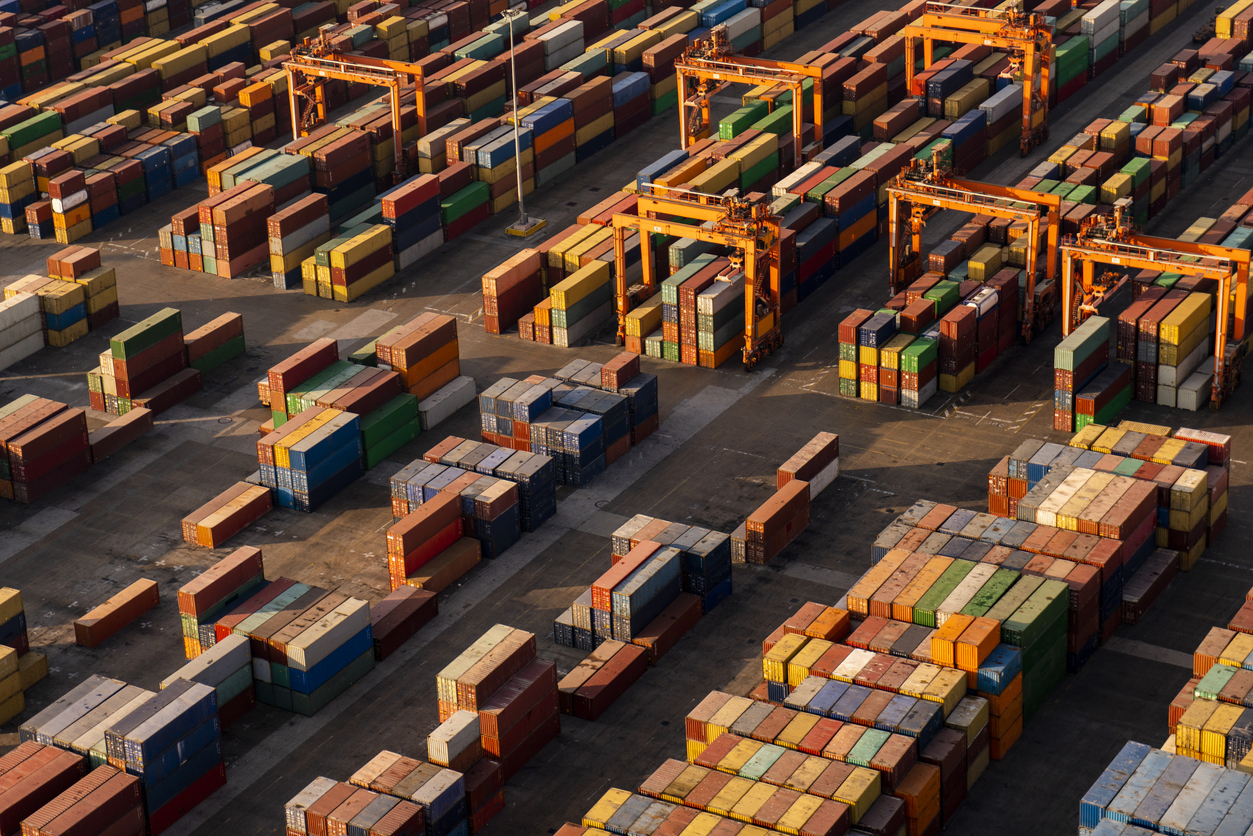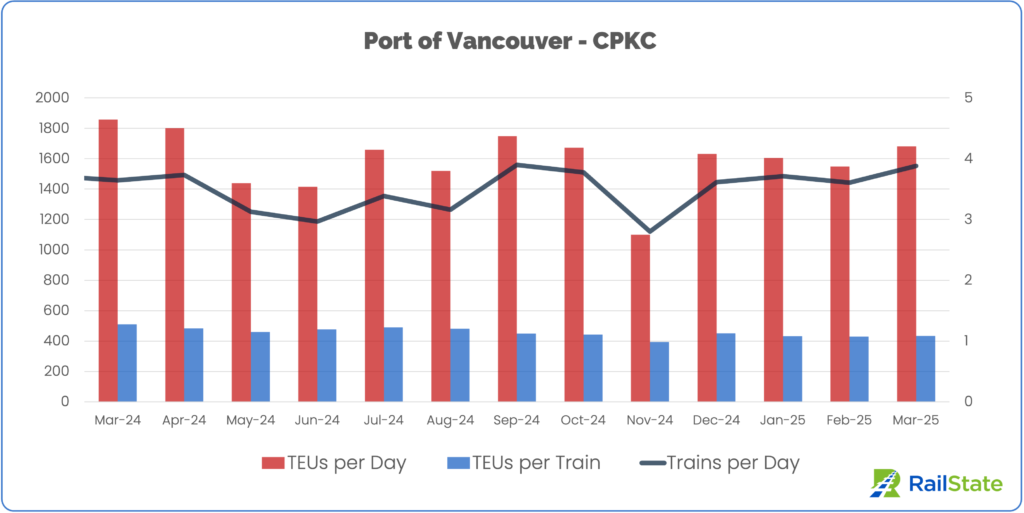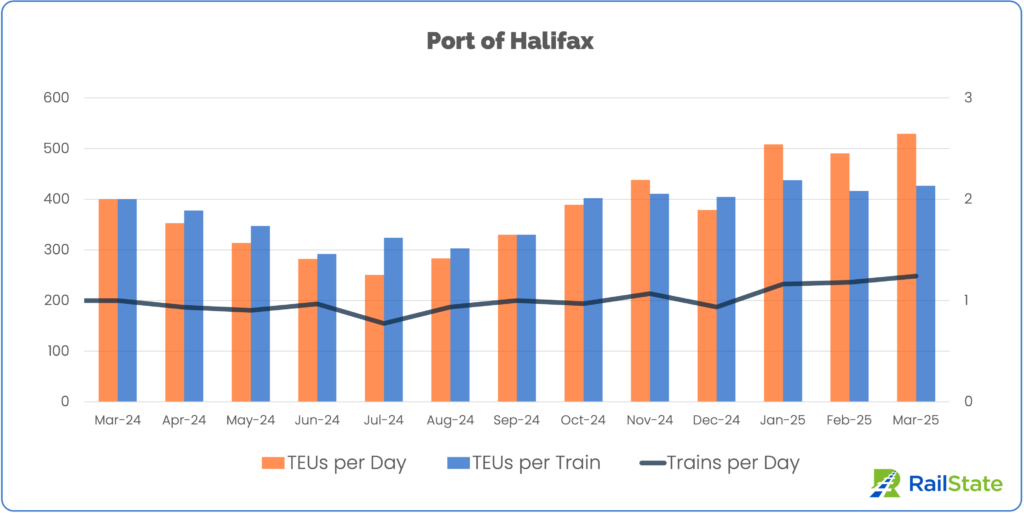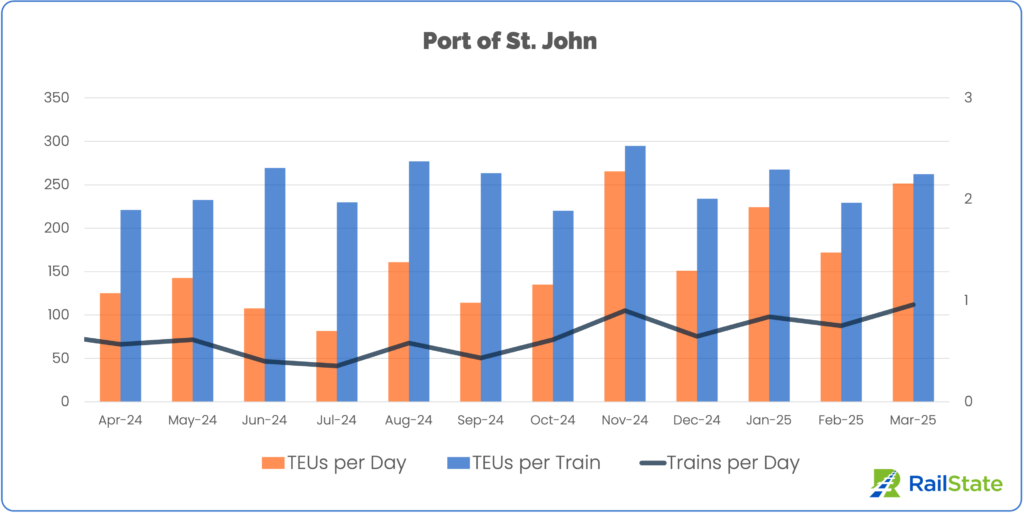Canadian National, CPKC, Freight Rail, Intermodal, Logistics, RailState
Container Crunch Canada: Tackling Increased Dwell, March 2025
- By ddevoe

With the Canadian ports experiencing escalating container pressure from increased volumes and shifting vessel arrivals from severe weather in the North Atlantic, container dwell has risen significantly in March.
RailState, the only source of rail network data for inland intermodal movements, monitors railroad performance across Canada, including at the West Coast and East Coast ports.
Through March 25, RailState data showed increased train volume and larger trains across CN’s network to address the influx of containers. CPKC, on the other hand, has made fewer changes in train volumes or train size.
Port of Vancouver
According to the latest Container Terminal Performance Update from the Port of Vancouver on March 27, container dwell times remain a problem since the beginning of the year, especially for CPKC. Despite some recent reductions in footprint, CPKC still has more than 111,000 feet of containers sitting at Deltaport for more than seven days, down from a peak nearing 160,000 feet. In comparison, CN has decreased on-dock footage across all Vancouver terminals in recent weeks.
Canadian National
To tackle the recent increases in container volume through Vancouver, CN has added more trains and significantly expanded the average train size. That resulted in a 25% increase in daily TEU movement and a consistent decline in on-dock footage and dwell in March.
CN’s train volumes and train sizes are also up compared to last year.
TEUs per Day
- Compared to March 2024: +11.4%
- Compared to February 2025: +25.2%
TEUs per Train
- Compared to March 2024: +9.1%
- Compared to February 2025: +15.2%
Trains per Day
- Compared to March 2024: +2.1%
- Compared to February 2025: +8.7%

Canadian Pacific Kansas City
CPKC has made few changes from last month. The modest increase in train volume (7.6%) and no real change in train size has not kept up with the recent influx of containers to Vancouver.
Compared to a year ago, CPKC is surprisingly moving less volume, driven mostly by smaller trains carrying 15% fewer TEUs on average.
TEUs per Day
- Compared to March 2024: -9.5%
- Compared to February 2025: +8.5%
TEUs per Train
- Compared to March 2024: -15.0%
- Compared to February 2025: +0.9%
Trains per Day
- Compared to March 2024: +6.4%
- Compared to February 2025: +7.6%

Port of Prince Rupert
Increases in inland traffic from the Port of Price Rupert have been more dramatic than at other ports.
With much larger trains (425 TEUs per train in February to 529 TEUs per train so far this month) and an additional train every other day, daily TEU volume is up 71.6% through the increasingly popular northern port.
Volume through Prince Rupert is also up compared to last year, during which the western ports had a very hot start to the year that started to cool in early summer.
TEUs per Day
- Compared to March 2024: +7.4%
- Compared to February 2025: +71.6%
TEUs per Train
- Compared to March 2024: +8.3%
- Compared to February 2025: +24.5%
Trains per Day
- Compared to March 2024: -0.8%
- Compared to February 2025: +37.9%

Port of Halifax
March continues to highlight Halifax’s consistent growth in container volume. Daily TEU volume moving inland from Halifax is at its highest point in more than a year and 32.3% above last year’s volumes.
Most of the growth at Halifax has been from increased train volume and not from larger trains.
Intermodal train volume is up 24% from a year ago while those trains are only moving 6.7% more containers.
TEUs per Day
- Compared to March 2024: +32.3%
- Compared to February 2025: +7.9%
TEUs per Train
- Compared to March 2024: +6.7%
- Compared to February 2025: +2.5%
Trains per Day
- Compared to March 2024: +24%
- Compared to February 2025: +5.2%

Port of St. John
The Port of St. John has also seen increased train volume and train sizes, resulting in a near 50% jump in daily TEU volume moving inland.
TEUs per Day
- Compared to February 2025: +46.3%
TEUs per Train
- Compared to February 2025: +14.3%
Trains per Day
- Compared to February 2025: +28.0%

For additional information about this report or to receive other updates from RailState, please reach out to contact@railstate.com or subscribe to our blog.
Categories
- AI (16)
- BNSF (19)
- Canadian National (32)
- CPKC (30)
- Freight Rail (165)
- Intermodal (1)
- Logistics (128)
- RailState (165)
- Technology (16)
- Uncategorized (3)
- Union Pacific (15)
Copyright © 2025
RailState LLC


